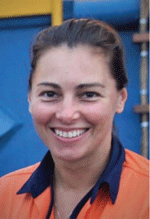Biofouling risk management for the importation of a floating production, storage and offloading (FPSO) facility and the central processing facility (CPF); the world’s largest semi-submersible platform
Nick Gust A , Ashley Coutts A , Patrick Lewis A , Rene Tigges A , Jake Prout B C and Shannon Carter BA Biofouling Solutions Pty Ltd (BFS), 244 Summerleas Road, Kingston, Tas. 7050, Australia.
B INPEX Operations Australia (INPEX), 100 St Georges Terrace, Perth, WA 6000, Australia.
C Corresponding author. Email: jake.prout@inpex.com.au
The APPEA Journal 59(2) 596-600 https://doi.org/10.1071/AJ18113
Accepted: 7 March 2019 Published: 17 June 2019
Abstract
Two key facilities for the INPEX-operated Ichthys LNG project; the central processing facility (CPF) and floating production, storage and offloading (FPSO), were constructed in South Korean ports and towed to offshore Australian waters. To meet regulatory requirements for their importation, and mitigate potential invasive marine species (IMS) introduction, species-specific biofouling risk assessments were completed, and a series of management measures implemented. Risk assessments quantified the theoretical likelihood of the facilities introducing IMS via biofouling. The assessments considered (but were not limited to) the type of antifouling coating (AFC), time alongside, niche areas, and likelihood of IMS surviving in offshore waters at the Ichthys Field if translocated. The two facilities had different AFCs on their submerged hulls (CPF: biocidal, FPSO: non-biocidal). The theoretical risk of introducing IMS to Australian waters was considered ‘uncertain’, requiring completion of an extensive pre-mobilisation cleaning program in-water (CPF >600 dive hours and FPSO 2381 dive hours). The FPSO was cleaned twice due to a delay and recolonisation on the non-biocidal AFC. To determine the most efficient cleaning methods, various in-water cleaning technologies were trialled. Due to the size and complexity of the facilities, biofouling inspectors were deployed throughout the operation to increase confidence in the outcomes. After the arrival of the facilities at the Ichthys Field, dedicated underwater surveys were conducted to assess biofouling communities and collect specimens for molecular analysis, using a specially designed sampling tool. The associated outcomes demonstrated that the risk was acceptable and had been reduced to as low as reasonably practicable, validating the novel approach taken.
Keywords: ALARP, as low as reasonably practicable, IMS, invasive marine species, marine biosecurity.

Nick Gust is a researcher, consultant and project manager in academic and applied marine ecology. His skills and expertise are gleaned from decades of research and consultancy in marine ecology and biosecurity. Nick joined Biofouling Solutions Pty Ltd in 2010 where his work has focused on improving understanding of marine biosecurity risks, and pragmatic management to reduce translocation of invasive marine species (IMS) via vessels and marine infrastructure. He has conducted IMS inspections and co-ordinated decontamination operations for large, complex vessels in a dozen countries. Nick is a current member of the IMarEST Biofouling Management Expert Group, and project leader for a trans-Tasman research program investigating treatment options for internal seawater systems on vessels. |

Ashley Coutts has extensive experience and skills relevant to the effective management of biofouling and invasive marine species (IMS). His Masters and PhD research have focused on assessing the biosecurity risks associated with vessel biofouling as a vector for IMS. Ashley previously worked for the Commonwealth Government, with the Department of Agriculture, Fisheries and Forestry’s (DAFF) Invasive Marine Species Program as Assistant Manager and Australian Quarantine and Inspection Service (AQIS) and as a Marine Pest Advisor. Ashley had considerable input into the development of Australia’s proposed Biofouling Management Requirements and other IMS policies. He was also an active member of the Consultative Committee on Introduced Marine Pest Emergencies (CCIMPE), the National Introduced Marine Pests Coordination Group (NIMPCG) and other technical advisory groups. Prior to this, Ashley was a Marine Biosecurity Scientist with Cawthron Institute in New Zealand, where he undertook scientific research and consultancy involving various aspects of biofouling, IMS research and management. Ashley is presently Managing Director of Biofouling Solutions and responsible for managing a team of marine scientists who specialise in the management of biofouling and IMS issues. |

Patrick Lewis’s experience cuts across science, consulting, environmental policy and international conservation. His research has specialised in the risk of invasive marine species introductions into the remote subantarctic islands and Antarctica and has focused on vector analysis, risk assessments and ecological experiments to determine priority invasive marine species for management. Patrick’s previous roles include the Assistant Manager of the Invasive Marine Species Program at the Department of Agriculture, Fisheries and Forestry (DAFF), Canberra and the Technical Officer for the Consultative Committee on Introduced Marine Pest Emergencies (CCIMPE). Following his time with DAFF, Patrick moved to Norway to manage the Responsible Industry elements of the World Wildlife Fund (WWF) International Arctic Program where he was responsible for introducing sustainable practices for the rapidly expanding hydrocarbon, fisheries and shipping industry sectors in the Arctic. Patrick is presently a Principal Scientist of Biofouling Solutions, and responsible for a range of projects delivering specialised advice and services to the maritime sector to assist in managing biofouling. |

Renee Tigges graduated from the Australian Maritime College in 1999 with a Bachelor of Applied Science (Fisheries). Since graduating Renée has held research support and technical roles with The Ecology Laboratory Pty Ltd, Centre for Research on Ecological Impacts of Coastal Cities (EICC), UNSW School of Biological, Earth and Environmental Sciences (BEES), and the Institute for Marine and Antarctic Studies (IMAS). Renée’s experience in intertidal, subtidal and benthic marine ecology and taxonomy has provided a solid foundation for working with IMS and biofouling. Renée joined Biofouling Solutions in January 2012 and is endorsed as a primary IMS Inspector as part of Biofouling Solutions’ Quality Management System. To date, Renée has conducted numerous IMS inspections and coordinated cleaning operations of vessels in Singapore, Indonesia, Malaysia, Hong Kong, South Korea, China, Norway, Finland, Estonia and Western Australia. When not in the field on IMS Inspections, Renée undertakes desktop work such as; Vessel IMS Risk Assessments, bespoke Pre-mobilisation Biofouling Management Plans and tailored Biofouling Management Plans and Record Books (according to the IMO Guidelines). |

Jake Prout is an environmental advisor with over 15 years’ experience in the mining, oil and gas sector. He is a collaborative project manager experienced in delivering environmental approvals and establishing environmental management systems to implement large and small scale projects in offshore and onshore environments. Since joining INPEX, Jake has been accountable for the planning and delivery of project critical environmental and regulatory approvals for the construction and operation of the 890 km subsea Gas Export Pipeline, a Central Processing Facility, Floating Production Storage Offloading (FPSO) facility, associated subsea infrastructure and supporting vessels. |

Shannon Carter is a marine scientist with over 11 years of environmental management and advisory experience in the mining, oil and gas sector. Through her various roles, she has gained significant experience in the preparation and delivery of environmental approvals, including complex environmental impact assessments and the management and execution of a range of environmental studies and surveys. She has co-ordinated and been involved in numerous biofouling risk assessments, inspections and invasive marine species (IMS) monitoring programs. In her role at INPEX, Shannon was the marine biosecurity specialist, who provided technical advice and support to the effective management of IMS risk (biofouling and ballast water) for the Ichthys Project. |
References
Lockwood, J. L., Cassey, P., and Blackburn, T. (2005). The role of propagule pressure in explaining species invasions. Trends in Ecology & Evolution 20, 223–228.| The role of propagule pressure in explaining species invasions.Crossref | GoogleScholarGoogle Scholar |
Simberloff, D. (2009). The role of propagule pressure in biological invasions. Annual Review of Ecology Evolution and Systematics 40, 81–102.
| The role of propagule pressure in biological invasions.Crossref | GoogleScholarGoogle Scholar |


